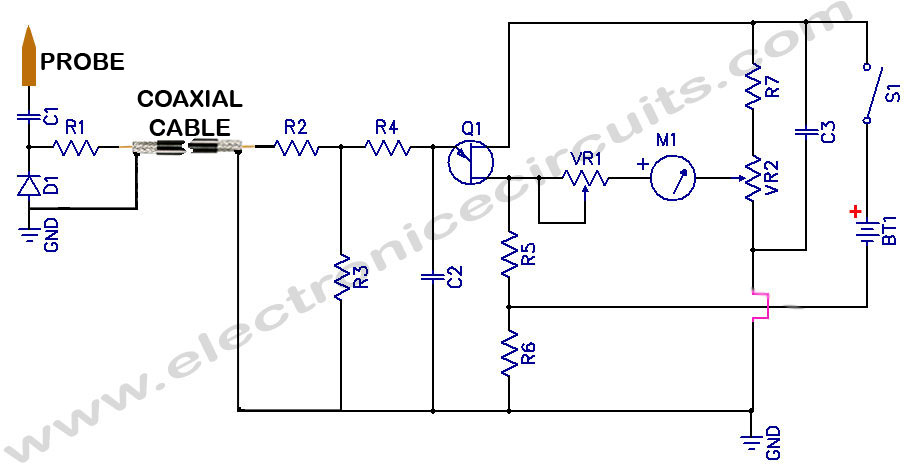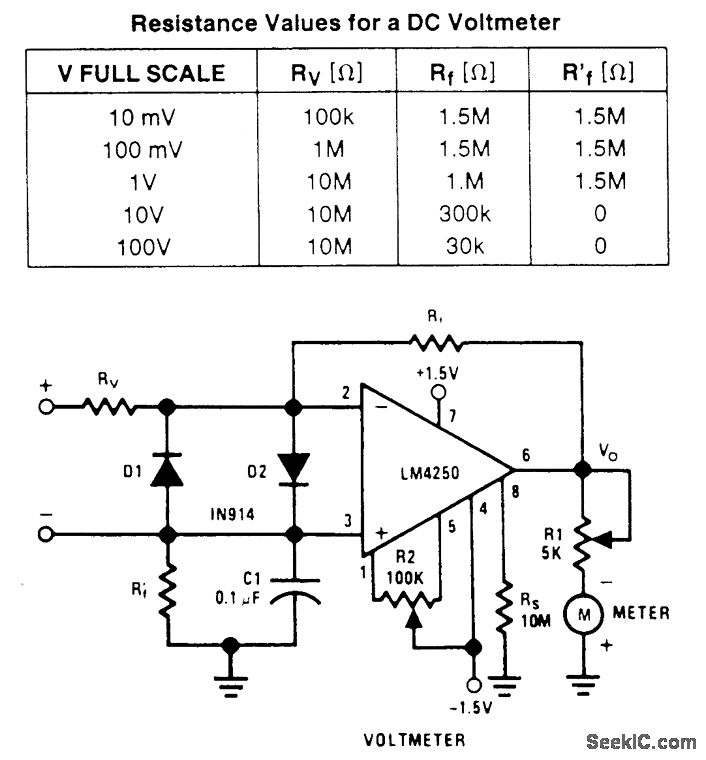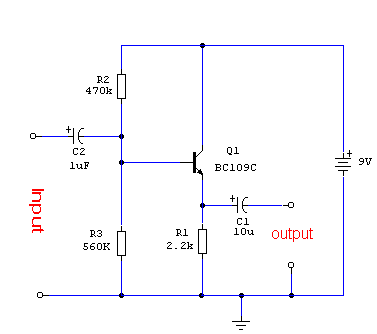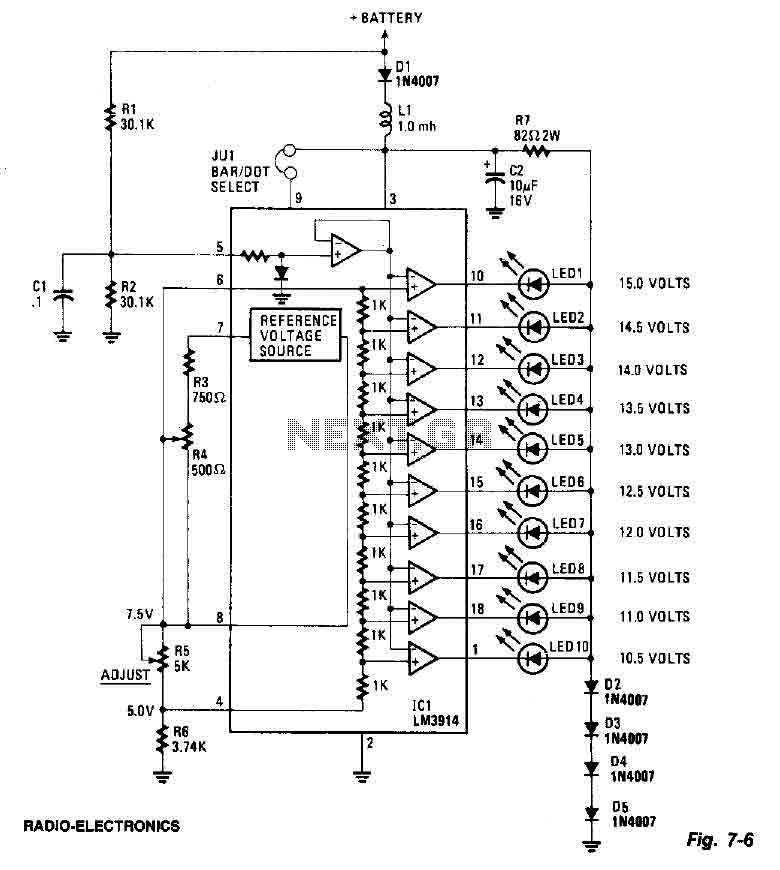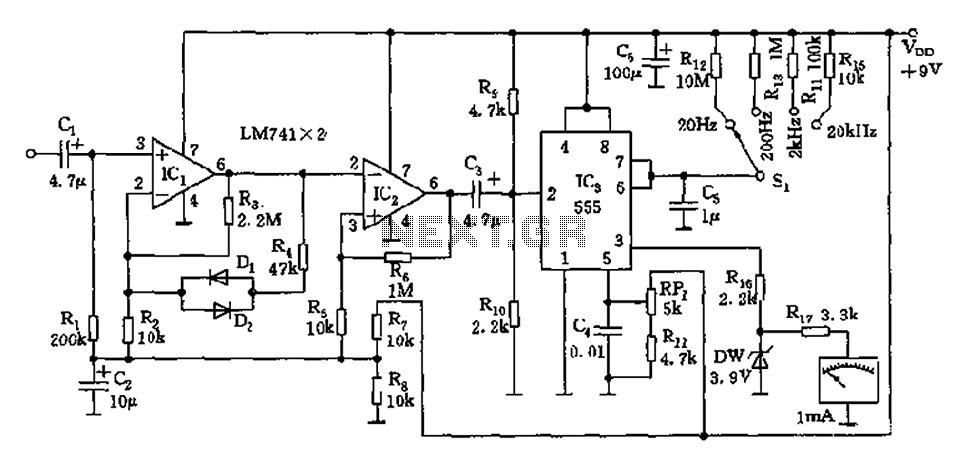
RMS Reading Voltmeter

The RMS value of a sinusoidal waveform is measured using an average reading voltmeter, which is calibrated to display RMS values. This method is simple and cost-effective. However, when measuring the RMS value of non-sinusoidal waveforms, a true RMS reading voltmeter is necessary. A true RMS reading voltmeter provides a meter indication by sensing the heating power of the waveform, which is proportional to the square of the RMS value of the voltage. A thermocouple is employed to measure the heating power of the input waveform, with the heater supplied by an amplified version of the input waveform. The output voltage of the thermocouple is proportional to the square of the RMS value of the input waveform. Additionally, a balancing thermocouple is utilized in the same thermal environment to mitigate the issues arising from the non-linear behavior of the thermocouple. The non-linearity of the input circuit thermocouple is canceled by the similar non-linear effects of the balancing thermocouple. These thermocouples are part of a bridge in the input circuit of a DC amplifier, as depicted in the block diagram. The AC waveform to be measured is applied to the heating element of the main thermocouple through an AC amplifier. In the absence of any input waveform, the outputs of both thermocouples are equal, resulting in a zero error signal at the input to the DC amplifier, which indicates zero on the connected meter. When the input waveform is applied, the output of the main thermocouple disrupts the balance, producing an error signal that is amplified by the DC amplifier and fed back to the heating element of the balancing thermocouple. This feedback current reduces the error signal until it reaches zero, achieving a balanced bridge condition. In this state, the feedback current supplied by the DC amplifier to the heating element of the balancing thermocouple equals the AC current flowing in the heating element of the main thermocouple. Consequently, this direct current is directly proportional to the RMS value of the input AC voltage and is indicated by the meter connected to the output of the DC amplifier. The PMMC meter can be calibrated to directly read the RMS voltage. This method allows for the measurement of the RMS value of any voltage waveform, provided that the peak excursions of the waveform do not exceed the dynamic range of the AC amplifier.
In the context of designing a true RMS voltmeter, the circuit typically consists of several key components: an AC amplifier, thermocouples, a DC amplifier, and a PMMC meter. The AC amplifier is crucial for boosting the input signal to an appropriate level before it reaches the heating element of the main thermocouple. This ensures accurate measurement of the heating power generated by the AC signal.
The main thermocouple, which is sensitive to the heating power, converts the thermal energy generated by the input AC signal into a measurable voltage. The balancing thermocouple, placed in the same thermal environment, serves to compensate for any non-linearities in the main thermocouple's response. This arrangement is essential for maintaining measurement accuracy, especially in non-linear waveform scenarios.
The DC amplifier plays a pivotal role in processing the error signal produced when the input waveform is applied. It amplifies this error signal and provides feedback to the balancing thermocouple, adjusting the heating current until the system reaches a balanced state. This feedback mechanism is critical for achieving a stable reading on the PMMC meter.
Moreover, the calibration of the PMMC meter is essential for ensuring that the readings correspond accurately to the RMS values of the input waveforms. The calibration process involves setting the meter to read zero when no input is present and adjusting it to reflect the correct RMS value during operation.
Overall, the design of a true RMS voltmeter is a sophisticated process that combines thermal measurement principles, feedback control systems, and precise calibration techniques to provide accurate RMS voltage readings across a variety of waveform shapes.RMS value of the sinusoidal waveform is meas ured by the average reading voltmeter of which scale is calibrated in terms of rms value. This method is quite simple and less expensive. But sometimes rms value of the non-sinusoidal waveform is required to be measured. For such a measurement a true rms reading voltmeter is required. True rms reading v oltmeter gives a me ter indication by sens ing heating power of waveform which is proportional to the square of the rms value of the voltage. Thermo-couple is used to measure the heating power of the input waveform of which heater is sup plied by the amplified version of the input waveform.
Output voltage of the thermo couple is proportional to the square of the rms value of the input waveform. One more thermo-couple, called the balancing thermo-couple, is used in the same thermal environment in order to overcome the difficulty arising out of non-linear behaviour of the thermo-couple.
Non-linearity of the input circuit thermo-couple is cancelled by the similar non-linear effects of the balancing thermo-couple. These thermo-couples form part of a bridge in the input circuit of a dc amplifier, as shown in block diagram.
AC waveform to be measured is applied to the heating element of the main thermo couple through an ac amplifier. Under absence of any input waveform, output of both thermo-couples are equal so error signal, which is input to dc amplifier, is zero and therefore indicating meter connected to the output of dc amplifier reads zero.
But on the application of input waveform, output of main thermo-couple upsets the balance and an error signal is produced, which gets amplified by the dc amplifier and fedback to the heating element of the balancing thermo-couple. This feedback current reduces the value of error signal and ultimately makes it zero to obtain the balanced bridge condition.
In this balanced condition, feedback current supplied by the dc amplifier to the heating element of the balance thermo-couple is equal to the ac current flowing in the heating element of main thermo-couple. Hence this direct current is directly proportional to the rms value of the input ac voltage and is indicated by the meter connected in the output of the dc amplifier.
The PMMC meter may be calibrated to read the rms voltage directly. By this method, rms value of any voltage waveform can be measured provided that the peak excursions of the waveform do not exceed the dynamic range of the ac amplifier. 🔗 External reference
In the context of designing a true RMS voltmeter, the circuit typically consists of several key components: an AC amplifier, thermocouples, a DC amplifier, and a PMMC meter. The AC amplifier is crucial for boosting the input signal to an appropriate level before it reaches the heating element of the main thermocouple. This ensures accurate measurement of the heating power generated by the AC signal.
The main thermocouple, which is sensitive to the heating power, converts the thermal energy generated by the input AC signal into a measurable voltage. The balancing thermocouple, placed in the same thermal environment, serves to compensate for any non-linearities in the main thermocouple's response. This arrangement is essential for maintaining measurement accuracy, especially in non-linear waveform scenarios.
The DC amplifier plays a pivotal role in processing the error signal produced when the input waveform is applied. It amplifies this error signal and provides feedback to the balancing thermocouple, adjusting the heating current until the system reaches a balanced state. This feedback mechanism is critical for achieving a stable reading on the PMMC meter.
Moreover, the calibration of the PMMC meter is essential for ensuring that the readings correspond accurately to the RMS values of the input waveforms. The calibration process involves setting the meter to read zero when no input is present and adjusting it to reflect the correct RMS value during operation.
Overall, the design of a true RMS voltmeter is a sophisticated process that combines thermal measurement principles, feedback control systems, and precise calibration techniques to provide accurate RMS voltage readings across a variety of waveform shapes.RMS value of the sinusoidal waveform is meas ured by the average reading voltmeter of which scale is calibrated in terms of rms value. This method is quite simple and less expensive. But sometimes rms value of the non-sinusoidal waveform is required to be measured. For such a measurement a true rms reading voltmeter is required. True rms reading v oltmeter gives a me ter indication by sens ing heating power of waveform which is proportional to the square of the rms value of the voltage. Thermo-couple is used to measure the heating power of the input waveform of which heater is sup plied by the amplified version of the input waveform.
Output voltage of the thermo couple is proportional to the square of the rms value of the input waveform. One more thermo-couple, called the balancing thermo-couple, is used in the same thermal environment in order to overcome the difficulty arising out of non-linear behaviour of the thermo-couple.
Non-linearity of the input circuit thermo-couple is cancelled by the similar non-linear effects of the balancing thermo-couple. These thermo-couples form part of a bridge in the input circuit of a dc amplifier, as shown in block diagram.
AC waveform to be measured is applied to the heating element of the main thermo couple through an ac amplifier. Under absence of any input waveform, output of both thermo-couples are equal so error signal, which is input to dc amplifier, is zero and therefore indicating meter connected to the output of dc amplifier reads zero.
But on the application of input waveform, output of main thermo-couple upsets the balance and an error signal is produced, which gets amplified by the dc amplifier and fedback to the heating element of the balancing thermo-couple. This feedback current reduces the value of error signal and ultimately makes it zero to obtain the balanced bridge condition.
In this balanced condition, feedback current supplied by the dc amplifier to the heating element of the balance thermo-couple is equal to the ac current flowing in the heating element of main thermo-couple. Hence this direct current is directly proportional to the rms value of the input ac voltage and is indicated by the meter connected in the output of the dc amplifier.
The PMMC meter may be calibrated to read the rms voltage directly. By this method, rms value of any voltage waveform can be measured provided that the peak excursions of the waveform do not exceed the dynamic range of the ac amplifier. 🔗 External reference
